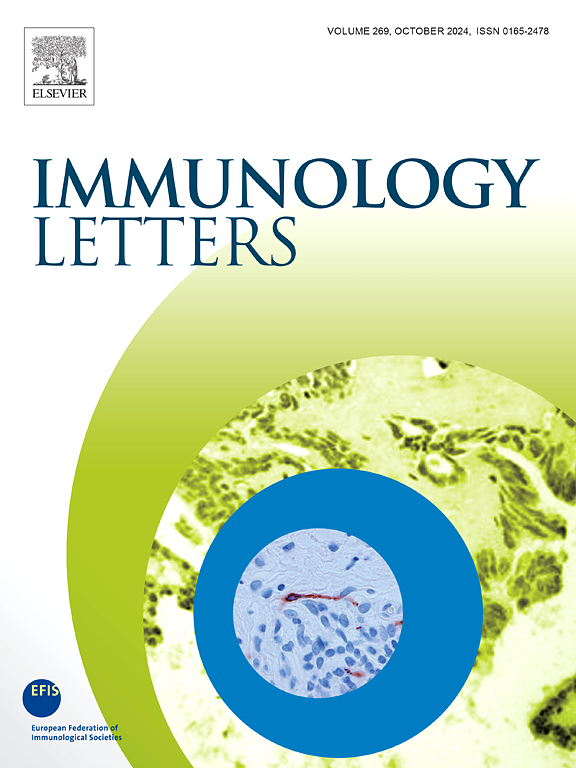揭示皮肤成纤维细胞的生物学潜能:对TNF-α的反应,突出细胞内信号通路和分泌组。
IF 2.8
4区 医学
Q3 IMMUNOLOGY
引用次数: 0
摘要
目的:在本研究中,我们检测了人皮肤成纤维细胞对炎症细胞因子的分子反应,以评估其作为免疫病理学研究模型的适用性。方法:用肿瘤坏死因子(TNF)-α刺激皮肤成纤维细胞,通过RNA-Seq分析其转录组。筛选差异表达基因以预测免疫途径和相互作用。细胞因子和信号通路在蛋白水平上得到验证。与免疫细胞类似,TNF-α引起成纤维细胞的转录和转导变化。结果:功能分析显示TNF-α信号和细胞趋化性显著富集(归一化富集评分分别为2.59和3.42)。我们还检测到核因子κB (NF-κB)靶基因的富集和NF- kb的活化,证实了其抑制剂i -κ ba的完全蛋白降解(p=0.0019)。MAPK/ERK和p38 MAPK通路也被激活。最后,我们观察到促炎细胞因子和趋化因子的显著分泌,如白细胞介素6 (p=0.02)、CXCL8 (p=0.027)、CCL2 (p=0.028)和CCL5 (p=0.016)。结论:本研究促进了对皮肤成纤维细胞对TNF-α反应的生物学认识,揭示了其细胞内通路和分泌组。它揭示了利用成纤维细胞作为体外模型的潜力来识别炎症驱动因素的技术,特别是当无法获得替代模型时。本文章由计算机程序翻译,如有差异,请以英文原文为准。
Unraveling the biological potential of skin fibroblast: responses to TNF-α, highlighting intracellular signaling pathways and secretome
Objective
In this study, we examined the molecular response of human skin fibroblasts to an inflammatory cytokine to evaluate their suitability as models for immunopathology research.
Methods
Skin fibroblasts were stimulated with tumour necrosis factor (TNF)-α, and the transcriptome was profiled via RNA-Seq. The differentially expressed genes were screened to predict immunological pathways and interactions. The cytokines and signaling pathways were validated at protein level. Similarly to immune cells, TNF-α caused transcriptional and transductional changes in fibroblasts.
Results
Functional analysis revealed significant enrichment of TNF-α signaling and cell chemotaxis (normalized enrichment score = 2.59 and 3.42). We also detected enrichment of nuclear factor kappa B (NF-κB) target genes and NF-kB activation, confirmed by complete protein degradation of its inhibitor IκBa (p = 0.0019). The MAPK/ERK and p38 MAPK pathways were also activated. Finally, we observed significant secretion of proinflammatory cytokines and chemokines, such as interleukin 6 (p = 0.02), CXCL8 (p = 0.027), CCL2 (p = 0.028) and CCL5 (p = 0.016).
Conclusion
This study advances the biological understanding of skin fibroblast responses to TNF-α, revealing their intracellular pathways and secretome. It discloses techniques for leveraging fibroblasts' potential as in vitro models to identify inflammatory drivers, particularly when alternative models are inaccessible.
求助全文
通过发布文献求助,成功后即可免费获取论文全文。
去求助
来源期刊

Immunology letters
医学-免疫学
CiteScore
7.60
自引率
0.00%
发文量
86
审稿时长
44 days
期刊介绍:
Immunology Letters provides a vehicle for the speedy publication of experimental papers, (mini)Reviews and Letters to the Editor addressing all aspects of molecular and cellular immunology. The essential criteria for publication will be clarity, experimental soundness and novelty. Results contradictory to current accepted thinking or ideas divergent from actual dogmas will be considered for publication provided that they are based on solid experimental findings.
Preference will be given to papers of immediate importance to other investigators, either by their experimental data, new ideas or new methodology. Scientific correspondence to the Editor-in-Chief related to the published papers may also be accepted provided that they are short and scientifically relevant to the papers mentioned, in order to provide a continuing forum for discussion.
 求助内容:
求助内容: 应助结果提醒方式:
应助结果提醒方式:


